Dense, But Enlightening
by Chris Wainscott
Yelena Dembo’s Opening Theory: Slav and Semi-Slav, ChessBase and PGN file formats, 2014, $39.95
Yelena Dembo’s Opening Theory: Slav and Semi-Slav is not an ebook per se. Instead, it is an insanely dense opening preparation database. As indicated in the introductory paragraph, if you were to print this out on a word processor it would span roughly 760 pages!
Here is the entire introductory text:
“Welcome to Yelena Dembo’s Chess Openings: Slav and Semi-Slav 1!
“With Yelena Dembo’s Chess Openings, Greek International Master Yelena Dembo invites you into her personal theoretical laboratory! The 100 very deeply annotated game examples provides an incredible theoretical resource. If you were to export this material into a word processor, there would be more than 760 pages of content! These examples are just a small fragment of the more than 37,000 instructive game examples, classified under more than 400 themes, that she has compiled for her work as a chess coach.
“IM Dembo is the author of several critically-acclaimed books for Everyman Chess; she won the Hungarian Women’s Championship in 2003; has eight medals from World and European championships; and has won prizes in dozens of men’s and women’s events. She has also written and self-published two middlegame books: “The Very Unusual Book About Chess” and “Conversation with a Professional Trainer – Methods of Positional Play.” To learn more visit her website at http://yelenadembo.com!
“To allow more convenient access to the material, we have installed an openings key in the database. Just click on the “Openings” tab. Good play!”
In essence, this database is a compilation of 100 different lines that are analyzed in enormous depth.
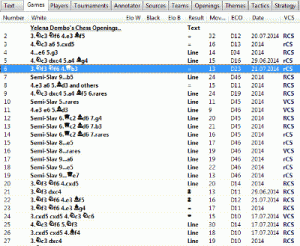
It presents every conceivable idea by giving you variations stacked upon variations stacked upon variations.
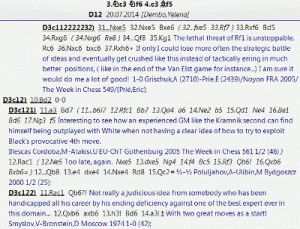
Other than the occasional sentence of text within the lines, there is very little explanatory prose. So this is not designed to teach you the basics of the Slav. However, if you are someone who currently plays the Slav or Semi-Slav from either the black or white side and are looking to hone your opening to a fine edge, then this could be exactly what you have been searching for.
As for myself, for the past few years I have been playing the Chebanenko Slav as black: 1.d4 d5 2.c4 c6 3.Nf3 Nf6 4.Nc3 a6
![[FEN "rnbqkb1r/1p2pppp/p1p2n2/3p4/2PP4/2N2N2/PP2PPPP/R1BQKB1R w KQkq - 0 5"]](https://chesscafe.com/wp-content/uploads/2014/09/review955c.gif)
[FEN “rnbqkb1r/1p2pppp/p1p2n2/3p4/2PP4/2N2N2/PP2PPPP/R1BQKB1R w KQkq – 0 5”]
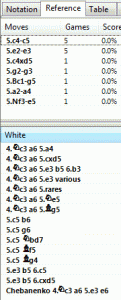
The main lines begin 5.c5 and 5.e3. As I have faced both I decided to work through the lines in depth, and I used ChessBase’s online database as a further reference tool. In the line 1.d4 d5 2.c4 c6 3.Nf3 Nf6 4.Nc3 a6 5.e3 e6, Dembo’s main continuation goes as follows: 6.b3 Bb4 7.Bd2 Nbd7 8.Bd3 0-0 9.0-0 Bd6 10.Re1 h6 11.Qc2 b6 12.e4 dxc4 13.bxc4 e5 14.Na4 Rb8 15.Bf1 b5 16.Nb2 c5 17.d5
![[FEN "1rbq1rk1/3n1pp1/p2b1n1p/1ppPp3/2P1P3/5N2/PNQB1PPP/R3RBK1 b - - 0 17"]](https://chesscafe.com/wp-content/uploads/2014/09/review955e.gif)
[FEN “1rbq1rk1/3n1pp1/p2b1n1p/1ppPp3/2P1P3/5N2/PNQB1PPP/R3RBK1 b – – 0 17”]
As a side note I did discover an interesting idea while analyzing with the computer after 16.Nb2
![[FEN "1rbq1rk1/3n1pp1/p1pb1n1p/1p2p3/2PPP3/5N2/PNQB1PPP/R3RBK1 b - - 0 16"]](https://chesscafe.com/wp-content/uploads/2014/09/review955f.gif)
[FEN “1rbq1rk1/3n1pp1/p1pb1n1p/1p2p3/2PPP3/5N2/PNQB1PPP/R3RBK1 b – – 0 16”]
Next I decided to look at the Czech Variation of the Slav which begins 1.d4 d5 2.c4 c6 3.Nf3 Nf6 4.Nc3 dxc4 5.a4 Bf5 6.Ne5
![[FEN "rn1qkb1r/pp2pppp/2p2n2/4Nb2/P1pP4/2N5/1P2PPPP/R1BQKB1R b KQkq - 0 6"]](https://chesscafe.com/wp-content/uploads/2014/09/review955g.gif)
[FEN “rn1qkb1r/pp2pppp/2p2n2/4Nb2/P1pP4/2N5/1P2PPPP/R1BQKB1R b KQkq – 0 6”]
![[FEN "5b1r/1pk2p2/2p5/p1n1nN1p/P2R4/2N3PB/1P2PP2/6K1 w - - 0 25"]](https://chesscafe.com/wp-content/uploads/2014/09/review955h.gif)
[FEN “5b1r/1pk2p2/2p5/p1n1nN1p/P2R4/2N3PB/1P2PP2/6K1 w – – 0 25”]
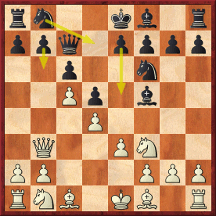
To illustrate the level of detail contained within the database, if you print out the analysis at move seven from the line above, there are pages and pages of analysis just to reach move eight. It depends on your playing strength as to whether this level of detail is necessary. The nice thing is that you can take only what you need. You can stick to the main line of each variation or you can investigate the myriad sidelines and develop your own conclusions.
Thus, Yelena Dembo’s Opening Theory: Slav and Semi-Slav is not for everyone. For a casual player certainly not, yet for someone aspiring to a higher level this can be an important part of your educational process. Higher-rated players will likely gain the most value from this compilation, and anyone playing correspondence chess should get this database regardless of their rating.
My assessment of this product: ![]()
© 2014 ChessEdu.org. All Rights Reserved.
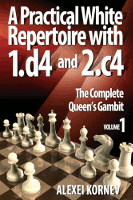
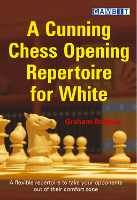
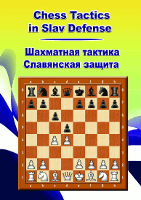
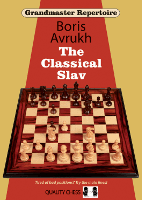
Leave a Reply